You need protection top to bottom. Leg and foot protection is important for many jobs. Here’s how to choose the best foot protection for your work environment.
When workers think of personal protective equipment (PPE), they often focus on hard hats, safety glasses and gloves. However, leg and foot protection is equally important and should not be overlooked. Workers can be exposed to leg or foot injuries from tasks, activities, or areas such as:
- Falling or rolling objects
- Exposure to hot substances or electrical hazards
- Walking on slippery or wet surfaces
- Walking on surfaces with sharp objects like nails
- Operating tools such as tampers or jack hammers
- Pouring, washing, or spraying chemicals or materials
- Lifting or working with heavy objects such as barrels
OSHA General Industry Standard 1910.136(a) The employer shall ensure that each affected employee uses protective footwear when working in areas where there is a danger of foot injuries due to falling or rolling objects, or objects piercing the sole, or when the use of protective footwear will protect the affected employee from an electrical hazard, such as a static-discharge or electric-shock hazard, that remains after the employer takes other necessary protective measures.
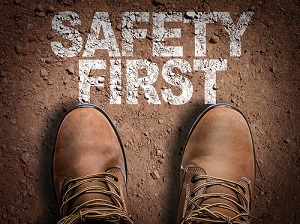
OSHA requires that adequate foot protection be used whenever the work conditions pose hazards that could cause a foot injury. When determining footwear requirements, many factors should be considered during the hazard assessment process, including:
- Work Operations
- Tasks Performed
- Walking/Working Surfaces
- Environmental Conditions
- Chemical Contaminants
- Electrical Hazards
OSHA Construction Standard 1926.28(a) The employer is responsible for requiring the wearing of appropriate personal protective equipment in all operations where there is an exposure to hazardous conditions.
Because every organization, work facility and job site is unique, there may be different footwear requirements for the work location, or the specific task being performed. It’s important that employers clearly communicate the personal protective equipment (PPE) requirements and it’s equally important that employees understand and comply or ask questions if they need clarification on the PPE specifications.
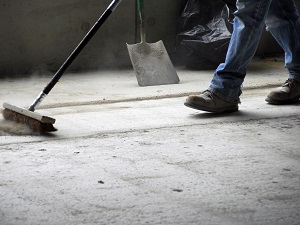
Tips for choosing work boots and ensuring foot safety on the job:
- Choose a boot that has deep treads or patterns and/or that are oil-resistant.
- If needed, select a boot that provides a steel or composite toe.
- Puncture-resistant boots should meet the ASTM F2413 PR requirements.
- Adding cost-effective accessories like quality insoles can make boots more comfortable.
- When working around heavy equipment or machinery, watch where you place your feet, and be cautious of your surroundings.
- Work in areas that have good lighting.
- Practice good housekeeping.
OSHA Construction Standard 1926.95(a) says that protective equipment, including personal protective equipment for eyes, face, head, and extremities, protective clothing, respiratory devices, and protective shields and barriers, shall be provided, used, and maintained…
Basic steel toe or hard toe work boots should be considered when performing common construction activities such as lifting heavy objects. Steel or hard toe shoes must meet specific standards for protection.

In addition to toe protection, using some tools such as jack hammers and tampers may require the addition of metatarsal protection. Metatarsal guards protect the bones on the top of the feet.
OSHA Construction Standard 1926.95(d)(2) and General Industry Standard 1910.132(h)(2) The employer is not required to pay for non-specialty safety-toe protective footwear (including steel-toe shoes or steel-toe boots) and non-specialty prescription safety eyewear, provided that the employer permits such items to be worn off the job-site.
It’s important to choose protective footwear that will protect your feet from the potential hazards that might be found on the job.
- Heat-Resistant – durable in hot environments
- Insulated – for warmth in cold working conditions
- Slip-Resistant – provides traction on wet or oily floors
- Water-Resistant – repels water
- Waterproof – inner liner to keep feet dry
- Metatarsal Guard – additional protection for the top of the foot
- Electrical Hazard (EH) – additional protection from electrical hazards
- Static Dissipative (ESD) – minimizes static electricity build-up
- Chemical-Resistant – made with products like rubber, neoprene, or PVC
- Puncture-Resistant (PR) Sole – for sharp object hazards like nails or broken glass
- Safety Toe – integrated steel, metal, or composite toe for falling object and crushing hazards
OSHA Construction Standard 1926.95(c) and General Industry Standard 1910.132(c) All personal protective equipment shall be of safe design and construction for the work to be performed.

When choosing new protective footwear to wear on the job, take some time with the selection process to ensure you get the best fit.
While offering optimal protection, it’s a misconception that work shoes or boots are typically uncomfortable or even painful to wear. But if your work shoes or boots don’t fit properly, then they probably won’t be comfortable.
Once you have determined the type of protective footwear required with the safety features that will protect you on the job, then consider these tips when making your footwear choice:
- Measure both feet. Some people have one foot that is slightly bigger than the other or have feet that require a wider width shoe.
- Go shopping in the afternoon or evening. Throughout the day your feet swell and expand. Trying on shoes towards the end of the day will help you figure out which style is best.
- Wear a normal work sock. Something you would typically wear on a workday.
- Try both shoes on and walk around.
- Rotate between two pairs. Don’t wait until your work shoes/boots are totally worn out before you get a new pair. If you can rotate the new pair with the old pair for a period of time you can avoid some of the discomfort of “breaking in” your new footwear.
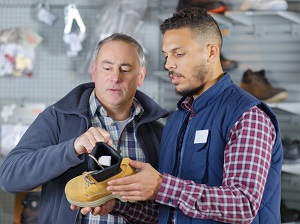
OSHA Standard 1910 Appendix B to Subpart I identifies the following occupations (noted as an incomplete list) for which foot protection should be routinely considered: shipping and receiving clerks, stock clerks, carpenters, electricians, machinists, mechanics and repairers, plumbers and pipe fitters, structural metal workers, assemblers, drywall installers and lathers, packers, wrappers, craters, punch and stamping press operators, sawyers, welders, laborers, freight handlers, gardeners and grounds keepers, timber cutting and logging workers, stock handlers and warehouse laborers.
Consider using foot protection designed for muddy, water soaked, or wet environments such as water proof rubber boots or boot covers and chest waders.
Boot covers or chemical resistant rubber boots should be worn when working with wet concrete or cement and similar chemicals.
Be sure to check that your books are labeled "slip and oil resistant" when walking on slippery or wet surfaces.
OSHA General Industry Standard 1910.132(d)(1) The employer shall assess the workplace to determine if hazards are present, or are likely to be present, which necessitate the use of personal protective equipment (PPE).
Choosing the proper protective footwear is critical but knowing when to replace your PPE is also important. Clean and inspect your protective footwear on a regular basis. Shoes and boots should be replaced when the tread pattern is gone from the rear two-thirds of the heel.
When inspecting the shoes or boots you wear to work, look for the following damage as a sign that they should be replaced:
- cracked, damaged or deteriorating midsoles
- ripped, frayed, or damaged leather or fabric
- cracks or holes on any portion of the footwear
- worn tread and reduced traction on the outsole
- damaged, ripped or worn insole
- water seepage inside the footwear
- soles starting to separate from the footwear
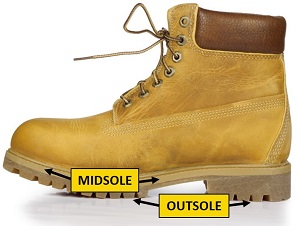
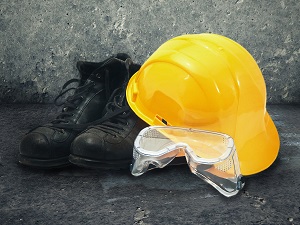
.jpg)

.jpg)